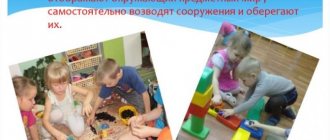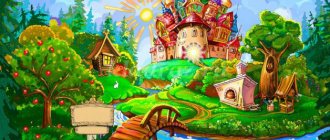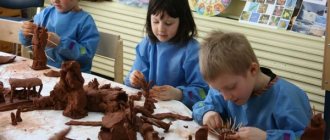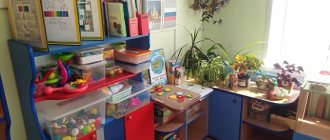The main tasks of theatrical activities in different age groups of preschool educational institutions
The main tasks of theatrical activities in different age groups of preschool educational institutions
Each of us spends our childhood in the world of role-playing games.
which help the child master the rules and laws of adults.
Each child plays in his own way, but in their games they all copy adults, their favorite heroes, and try to be like them. Children's games can be considered as improvised theatrical performances. The child is given the opportunity to play the role of an actor, director, decorator, prop maker, and musician. Making props, scenery, and costumes provides an opportunity for children’s visual and technical creativity
. Children draw, sculpt, sew, and all these activities acquire meaning and purpose as part of a common plan that excites children.
Particular importance in children's educational institutions can and should be given to theatrical activities
, all types of children's theater, because they help:
· form the correct model of behavior in the modern world;
· improve the child’s general culture and introduce him to spiritual values;
· introduce him to children's literature, music, fine arts, rules of etiquette, rituals, traditions, instill a sustainable interest;
· improve the skill of embodying certain experiences in the game, encouraging the creation of new images, encouraging thinking.
In addition, theatrical activity is a source of development of feelings and deep experiences of the child, i.e. it develops the child’s emotional sphere, forcing him to sympathize with the characters and empathize with the events being played out. The shortest path to emotional liberation of a child, removal of constriction, learning to feel and artistic imagination is the path through play, fantasy, and writing.
The improvement of speech is also closely related to theatrical activities, since in the process of working on the expressiveness of characters’ remarks and their own statements, the child’s vocabulary is imperceptibly activated, the sound culture of his speech and its intonation structure are improved.
Theatrical activities include acting out fairy tales, skits, role-playing dialogues based on illustrations, independent improvisations on topics taken from life (a funny incident, an interesting event, etc.); watching puppet shows and talking about them; dramatization games; acting out fairy tales and dramatizations; exercises to develop expressiveness of performance (verbal and non-verbal); exercises for the social and emotional development of children.
A huge role in organizing theatrical activities is played by the teacher, who skillfully guides this process. It is necessary that the teacher not only read or tell something expressively, be able to look and see, listen and hear, but also be ready for any “transformation”, that is, master the basics of acting, as well as the basics of directing skills. This is what leads to an increase in his creative potential and helps to improve the theatrical activities of children. The teacher must strictly ensure that with his acting activity and looseness he does not suppress a timid child and does not turn him only into a spectator. We must not allow children to be afraid to go “on stage” or to be afraid of making mistakes. It is unacceptable to divide into “artists” and “spectators,” that is, those who constantly perform and those who constantly stay to watch others “play.”
In the process of implementing a set of classes
The following tasks are solved for theatrical activities:
-development of creative abilities and creative independence of a preschooler;
— nurturing interest in various types of creative activities;
— mastering improvisational skills;
– development of all components, functions and forms of speech activity
— improvement of cognitive processes.
The basis of theatrical classes is theatrical play. Basic requirements for organizing theatrical games in kindergarten:
Ø Content and variety of topics.
Ø The constant, daily inclusion of theatrical games is a form of the pedagogical process, which makes them just as necessary for children as role-playing games.
Ø Maximum activity of children at the stages of preparation and conduct of games.
Ø Cooperation of children with each other and with adults at all stages of organizing a theatrical game.
The system of work for the development of theatrical activities is divided into three stages:
· artistic perception of literary and folklore works;
· mastering special skills for developing basic (“actor”, “director”) and additional positions (“screenwriter”, “designer”, “costume designer”);
· independent creative activity.
The pedagogical task is complicated by the synthetic nature of theatrical activity, in which perception, thinking, imagination, speech are in close relationship with each other and are manifested in different types of children's activity (speech, motor, musical, etc.).
Therefore, we can say that theatrical activity is integrative.
During theatrical games:
- children’s knowledge about the world around them expands and deepens; mental processes develop: attention, memory, perception, imagination; mental operations are stimulated; development of various analyzers occurs: visual, auditory, speech motor; vocabulary, grammatical speech, sound pronunciation, connected speech skills, melodic-intonation side of speech, tempo, expressiveness of speech are activated and improved; motor skills, coordination, smoothness, switchability, and purposefulness of movements are improved; the emotional-volitional sphere develops; behavior correction occurs; a sense of collectivism and responsibility for each other develops, and the experience of moral behavior is formed; the development of creative, search activity, and independence is stimulated; participation in theatrical games brings joy to children, arouses active interest, and captivates them.
We will reveal the tasks of working with children of different age groups.
2nd junior group
Children of this age demonstrate primary mastery of director's theatrical play.
– tabletop toy theatre, tabletop plane theatre, plane theater on flannelgraph, finger theatre. The process of mastering includes mini-productions based on the texts of folk and original poems, fairy tales, stories (“This finger is a grandfather ...”, “Tili-bom”, K. Ushinsky “Cockerel with his family”, A. Barto “Toys”, V. Suteev “Chicken and Duckling.”) The child begins to use finger theater figures in joint improvisations with an adult on given topics.
Tasks:
Ø Fostering positive moral ideals, the desire to be responsive, to correctly evaluate the actions of characters.
Ø Develop a sustainable interest in theatrical play activities.
Ø To achieve free expression of children’s emotions in gestures, facial expressions, movement, singing, and words.
Ø To achieve children's performing skills in creating an artistic image, using play, song, and dance creativity for this.
Ø Expand children’s ideas about the surrounding reality, about the past and future, about objects, customs and life, nature, etc.
Ø Let children consolidate their understanding of various types of theater - dramatization, floor theater, table theater.
Ø Enrich children's speech, achieve correct intonation and expressive speech.
Ø Encourage children to improvise on the theme of familiar fairy tales, stories, and come up with stories of their own composition.
Ø Develop children's memory, thinking, imagination, attention.
Ø Teach children to correctly evaluate themselves and their comrades.
Ø To arouse in children the desire to move, that is, to dance, and create a bright, plastic image.
Ø To foster children’s desire to “play,” that is, to act out fairy tales.
Ø Achieve the ability to use song, dance and game improvisations in independent activities.
Middle group
At this age, interest in theatrical games deepens .
Expansion of children's theatrical and gaming experience is carried out through
the development of dramatization games.
At the age of 4-5 years, the child masters different types of table theater: soft toys, wooden theater, cone theater, folk toy theater and plane figures. The riding puppet theater (without a screen, and by the end of the school year - with a screen), the spoon theater, etc. are also available to children. Children show performances based on the plots of Russian folk tales “Fox with a rolling pin”, “Zhikharka”, “Rukavichka”, “Bull” —tar barrel”, “Puff”, “Geese-swans”, etc.
Finger theater is more often used in independent activities, when a child improvises based on familiar poems and nursery rhymes, accompanying his speech with simple actions (“We lived with grandma”; S. Mikhalkov “Kittens”, 3ubkova “We shared an orange”).
Tasks
Ø Cultivate a sustainable interest in theatrical and gaming activities.
Ø Lead children to create an expressive image in sketches, dramatizations, song and dance improvisations.
Ø Expand their understanding of the objects around them. Develop the ability to identify the characteristics of objects (color, shape, size). Expand children's knowledge about the characters participating in theatrical and play activities.
Ø Replenish and activate children's vocabulary. Form intonation expressiveness of speech. To develop children's dialogical speech in the process of theatrical and play activities.
Ø To consolidate knowledge about the rules of manipulation with riding dolls.
Ø Continue to develop in children the desire to participate in dance improvisations with and without dolls.
Ø Maintain the desire to speak in front of children, parents, and kindergarten staff.
Senior group
In older preschool age, the theatrical and play experience deepens
through mastering different types of dramatization games and director's theatrical games. Along with figurative play sketches, improvisation games, and staging, older preschoolers have access to independent productions of performances, including those based on a “collage” of several literary works. For example, “A Journey through Fairy Tales”, “New Adventures of the Fairy Tales Heroes by C. Perrault”, etc. The experience of directorial play is enriched by puppets, dolls with a “living hand”, and cane dolls.
Texts for productions are becoming more complex. Russian folk tales and fables about animals (“The Fox and the Crane”, “The Hare and the Hedgehog”), works by L. Tolstoy, I. Krylov, M. Zoshchenko, N. Nosov began to be used in theatrical play.
Tasks
Ø Continue to develop a sustainable interest in theatrical and gaming activities.
Ø Improve children's performing skills in creating an artistic image, using game, song and dance improvisations for this purpose.
Ø Expand children's understanding of the surrounding reality. Improve children's ability to navigate in a group, hall, or kindergarten premises.
Ø To consolidate children’s ideas about various types of puppet theaters, to be able to distinguish between them and name them.
Ø Continue to enrich and activate children's vocabulary. Improve intonation expressiveness of speech. Develop dialogical and monologue forms of speech.
Ø To consolidate knowledge about the rules of manipulating dolls.
Ø Encourage children to improvise on the theme of familiar fairy tales, stories, and come up with their own stories individually and collectively, using dolls.
Ø Develop children's memory, thinking, imagination, attention.
Ø Foster a desire to play with theater dolls. Develop the ability to use song, dance, and game improvisations in independent activities.
Ø Support children’s desire to actively participate in holidays and entertainment, using the skills acquired in classes and in independent activities.
Preparatory group
In the preparatory group, the game material becomes even more complex. Theatrical performances include: staging of theatrical plays, children's operas, musical and rhythmic plays. Dramatization of Russian folk tales, songs, literary works; dramatization games: “The Starling and the Sparrow”, “Child Kittens”, music. E. Tilicheeva.
Tasks
Ø To improve the comprehensive development of children’s creative abilities through the means of theatrical art.
Ø Develop creative independence in creating an artistic image, using game, song, and dance improvisations for this purpose.
Ø Continue to expand children's knowledge about the surrounding reality. Deepen your understanding of objects, theatrical puppets, and scenery. Improve children's ability to navigate the premises of the kindergarten. Expand and clarify children’s ideas about the types of puppet theaters, be able to distinguish between them and name them.
Ø Continue to activate and clarify children’s vocabulary, expand their vocabulary. Improve dialogic and monologue forms of speech. Foster a culture of verbal communication. Improve the ability to compose short stories, tales from personal experience, using dolls.
Ø To consolidate knowledge about the rules of manipulating dolls.
Ø Strengthen the skills of improvising dialogues of characters in well-known fairy tales. Improve the skills of collective writing of stories from personal experience using theatrical puppets.
Ø Improve memory, attention, thinking, imagination, perception of children.
Ø To develop the creative independence of children, encouraging them to convey the mood and character of the music with the plasticity of their bodies, theatrical dolls, creating a bright dance image of the hero.
Ø Support children's initiative in individual and collective improvisations on children's musical instruments that accompany puppet shows and dramatizations.
Ø Encourage the desire to take an active part in holidays, leisure and entertainment, using improvisational skills acquired in classes and in independent activities.
Work organized in this way will contribute to the fact that theatrical play will also become a means of self-expression and self-realization of the child in various types of creativity, self-affirmation in a peer group. And the life of preschoolers in kindergarten will be enriched due to the integration of games and various types of art, which are embodied in theatrical and play activities.
Prepared
teacher second
qualification category.
Get text
Significance of the work
Theatrical activities according to the Federal State Educational Standard in preschool educational institutions help the teacher to raise active and bright personalities. Children learn to see unusual details in the world around them and create artistic images based on them.
Theatrical activities according to the Federal State Educational Standard in preschool educational institutions contribute to the formation of associative thinking in children. By trying themselves in different roles, children overcome shyness and self-doubt, become more relaxed and open to communication with peers.
Main areas of work
Costume play is a phenomenon with deep historical roots. Currently, it has become an independent type of activity characteristic of humans.
Theatrical activities according to the Federal State Educational Standard in preschool educational institutions contribute to solving the following tasks:
- teaching preschoolers spatial orientation skills;
- building a dialogue on a specific topic;
- voluntary tension and relaxation of individual muscle groups;
- memorizing texts (auditory and visual memory);
- observation;
- figurative thinking.
There are several techniques that help instill in preschoolers an interest in the performing arts.








